Essential Kiteboarding Supplies: A Comprehensive Guide
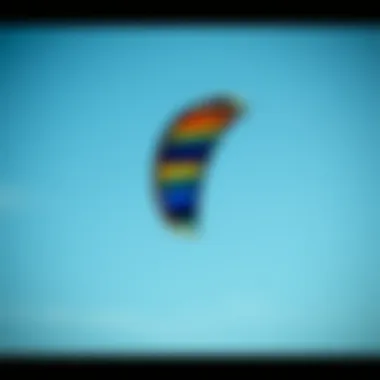

Intro
Kiteboarding isn’t just a sport; it’s a lifestyle that encompasses adventure, skill, and a connection to nature. This exhilarating experience requires not just passion but the right supplies to maximize safety and enjoyment. Whether you're a novice looking to dip your toes into the waters or a seasoned rider seeking the latest innovations, understanding the essentials is critical.
In this article, we will dissect the key supplies necessary for kiteboarding. By delving into gear specifications, safety measures, and maintenance routines, we aim to arm you with every bit of knowledge you need. It’s also vital to grasp how to navigate the marketplace effectively, ensuring you make sound investments. Let’s take a deep dive into the essentials, examining what each piece of equipment brings to the kiteboarding experience as well as how to care for it properly. We will also touch upon the latest advancements in technology that are shaping the sport.
With a thorough understanding of these elements, you will be prepared to conquer the waves and soar through the skies with confidence.
Gear Insights
Kiteboarding gear is more than just items on your shopping list; it’s a collection of tools that contribute to your overall success and safety on the water. From the kite to the board, each piece plays a vital role in your kiteboarding escapades.
Latest Gear Reviews
Kites
When selecting a kite, focus on size, shape, and material. The Duotone Evo stands out in reviews for its versatility—suitable for all skill levels. It provides a balanced performance in various wind conditions. On the other hand, for experts, the Slingshot RPM offers unmatched precision and responsiveness, making it a favorite for those looking to master advanced maneuvers.
Boards
Your choice of board greatly affects your riding style. The North Reach is favored for its light weight and exceptional control. It performs well under different sea conditions. Alternatively, the Liquid Force Drive is highlighted for its excellent upwind ability, crucial for longer rides.
Essential Gear for Beginners
If you're just starting your kiteboarding journey, a solid foundation of essential gear will set you on the right path. Consider these must-haves:
- A decent quality kite that suits moderate winds.
- A comfortable harness like the Mystic Warrior, designed to reduce back strain.
- A board that offers good stability, such as the Naish Motion.
- Safety gear including a helmet and impact vest—safety first!
"Investing in quality gear at the outset can save you from headaches later, literally and figuratively."
Techniques and Tips
Once you've gathered your gear, it's time to think about techniques and practices that ensure a smooth sailing experience.
Advanced Tricks and Techniques
For those with some experience under their belt, tackling more advanced tricks can elevate your performance. Practicing jumps and rotations like the handle pass requires a combination of strength, timing, and balance. Regular training sessions focused on these techniques will strengthen your muscles used for kite control, thus boosting your overall kiteboarding skills.
Safety Practices for Kiteboarders
Safety should never take a back seat. Familiarize yourself with weather patterns, and always check wind conditions before heading out. Here are some fundamental safety practices:
- Always kite with a buddy. An extra pair of eyes helps.
- Wear a life jacket to assist in floating should you get into trouble.
- Know your limits—don't push it if the conditions are rough.
Remember, kiteboarding is about having fun, but safety is paramount. With the right gear and practices in place, your enjoyment will soar to new heights.
Understanding Kiteboarding Supplies
Kiteboarding is not just a sport; it's an adrenaline-fueled adventure that demands the right gear. If you’re new to the scene or even if you’ve been around for a bit, understanding kiteboarding supplies is fundamental. Having the right equipment can make the difference between a breathtaking ride and a frustrating day on the water.
When it comes to gear, quality stands tall among the priorities because subpar equipment can lead to safety hazards and hinder performance. Right from the kite itself to the board, everything plays a crucial role in how well you can maneuver and navigate through the wind and waves. This guide will help navigate the often overwhelming choice of equipment.
The Importance of Quality Gear
Quality kiteboarding gear is like a sturdy bridge; it needs to hold up under all kinds of conditions. Picture this: You're slicing through the water, kite soaring above, everything feels perfect. Then, bam! The line snaps because it was low-quality. The thrill is gone, and you may end up in an unsafe situation. Investing in high-quality gear allows kiteboarders to enjoy their time on the water without the nagging worry of equipment failure.
Furthermore, top-notch gear often translates to better performance, allowing for sharper turns, higher jumps, and smoother landings. You wouldn’t attempt a cross-country hike with flip-flops, right? The same goes for kiteboarding—embracing quality gear enhances everything from comfort to skill demonstration.
Types of Kiteboarding Equipment
Navigating the world of kiteboarding supplies, one faces an array of equipment. Here’s a breakdown of the essential types:
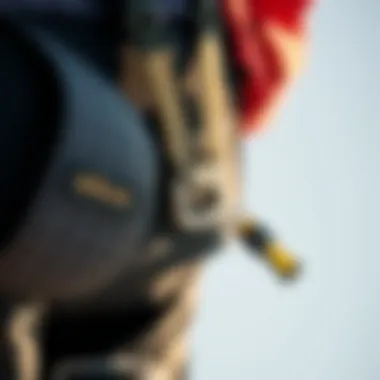
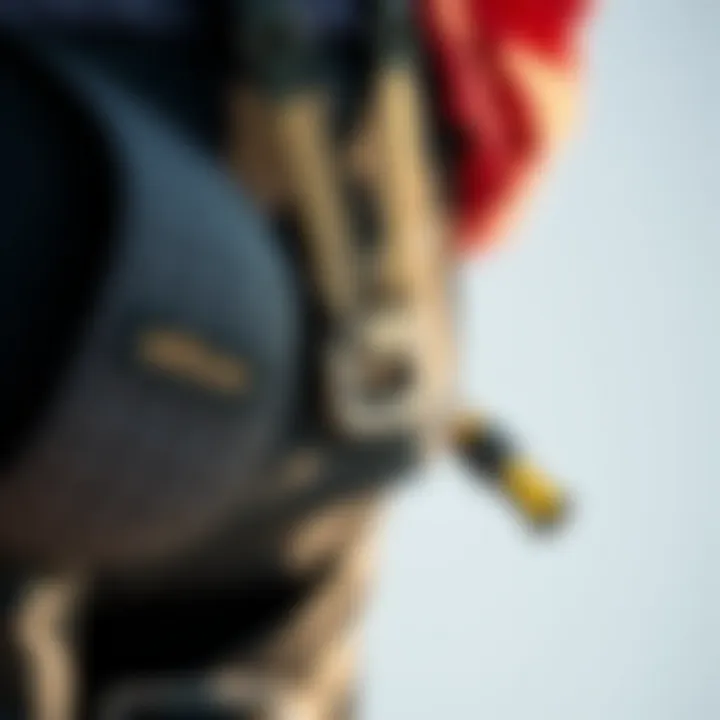
- Kites: These are the heart of the sport. They come in various shapes, sizes, and materials, designed for different conditions and rider preferences.
- Boards: From twin-tips to directional boards, the choice here affects control and riding style.
- Control Bars: This is your direct link to the kite. Picking the right size and configuration ensures better handling and responsiveness.
In essence, every piece contributes to the performance, safety, and enjoyment of kiteboarding. Proper understanding of these supplies helps kiteboarders choose wisely, tailoring their setup to their specific needs.
"Understanding your supplies is half the battle; the other half is mastering how to use them."
Core Kiteboarding Gear
Kiteboarding is a sport that hinges largely on specialized equipment, making core gear a pivotal focus for any kiteboarder, whether you are just clicking into the foot straps for the first time or an experienced pro chasing larger waves. This category of gear comprises the most essential items that determine not just your performance but also your safety and overall enjoyment on the water. Selecting high-quality kiteboarding gear can directly influence your skill progression and the extent to which you can push your boundaries in the sport.
Kites: Functionality and Specifications
The kite is your primary propulsion device when you're zipping across the water. Its functionality encompasses size, shape, and material, each playing distinct roles in how the kite interacts with wind and water.
When it comes to specifications, understanding aspects such as aspect ratio and bridge technology is vital. A kite with a higher aspect ratio tends to be faster and better at gliding, while a lower aspect ratio kite might be preferable for jumping and tricks. Materials like ripstop nylon or polyester are standard, but some high-end models feature advanced materials that enhance durability and decrease overall weight.
Additional factors to consider when selecting a kite include:
- Wind range: Ensure that the kite can handle the wind conditions typical of locations you frequent.
- Skill level: Certain types of kites are better suited for specific skill levels.
- Purpose: Freestyle, wave riding, or racing kites each have unique designs to cater to different riding styles.
Boards: Varieties and Features
The right board can feel like an extension of your body, making comfort and performance indispensable. Various types of boards exist, each tailored for different riding styles and conditions, from directional boards to twin-tips.
- Directional Boards: These are often shorter and designed for riding downwind. They're excellent for wave riding and provide superior control in rough waters.
- Twin-Tips: Versatile and perfect for beginners and freestyle riders, twin-tips can be ridden in either direction, allowing for a variety of tricks.
When evaluating board features, key points to ponder include:
- Flexibility: A stiffer board offers better performance in choppy waters, while a more flexible board provides better shock absorption during landings.
- Fin Setup: The number and type of fins can drastically affect ride stability and maneuverability.
- Length and Width: Smaller boards are generally faster but less stable, while larger boards offer better stability and control in light winds.
Control Bars: Choosing the Right Fit
Control bars serve as your command center while kiteboarding, allowing you to steer and adjust the power of your kite. Thus, choosing the right fit is imperative for both comfort and safety.
Several factors should guide your selection of control bars:
- Width: A wider bar allows for more responsive steering, while a narrower bar provides increased control at higher speeds.
- Line Length: Longer lines can give you more speed and power but can make the kite harder to control in gusty conditions.
- Safety Systems: Look for bars equipped with safety release mechanisms and easy depower features that can help you regain control quickly if things go awry.
With these considerations in mind, a well-thought-out gear selection can not only elevate your performance but also enrich your kiteboarding experience. Always keep an eye out for the nuances of each piece of equipment, as these small details can make a world of difference.
Safety Equipment in Kiteboarding
Safety in kiteboarding is paramount, as performances often flirt with the boundaries of thrill and danger. While the rush that comes from dancing with the wind can be exhilarating, it's crucial to have the right safety equipment in place to not just enhance enjoyment but also ensure rider protection. This section dives into the essential safety gear that every kiteboarder should consider. From harness types to personal flotation devices, understanding these elements allows both beginners and seasoned athletes to make informed decisions with confidence.
Harnesses: Types and Uses
Harnesses are a kiteboarder's lifeline, quite literally. They provide the critical connection between the rider and the kite. When selecting a harness, you typically encounter two primary types: seat harnesses and waist harnesses.
- Seat Harnesses: These wrap around the thighs and fit snugly, making them ideal for beginners. They offer higher back support, which can be beneficial for those who are just starting and may need a bit more stability.
- Waist Harnesses: These sit higher on the body and allow for more freedom of movement. They are favored by more experienced riders, especially those who engage in tricks or prefer a more dynamic style.
Each type has its particular appeal, depending on what you aim to achieve on the water. Remember, comfort is also a vital part of harness selection. If the fit isn't right, it can easily distract from the joy of kiteboarding.
Safety Leashes: The Essential Connection
The safety leash acts as a vital backup, ensuring that you maintain control over your kite even in the unexpected moments when things can go awry. A properly attached safety leash lets you detach from the kite, allowing it to fly away harmlessly from you.
When choosing a safety leash, look for features such as:
- Durability: A strong, well-constructed lever is essential. It needs to withstand the wear and tear of the sport.
- Length: Select a leash length that suits your style. Shorter leashes provide a more direct connection, while longer ones offer more freedom.
- Quick Release Mechanism: Make sure it has an intuitive system for swift release. This is crucial when you find yourself in an uncomfortable spot.
Investing in a reliable safety leash may considerably lessen the risks involved. As the saying goes, better safe than sorry.
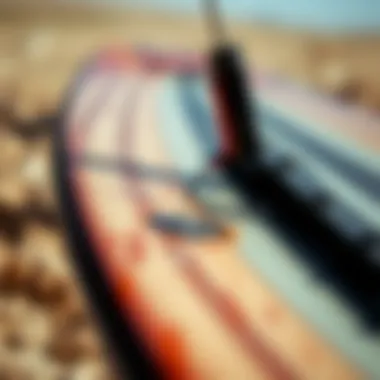
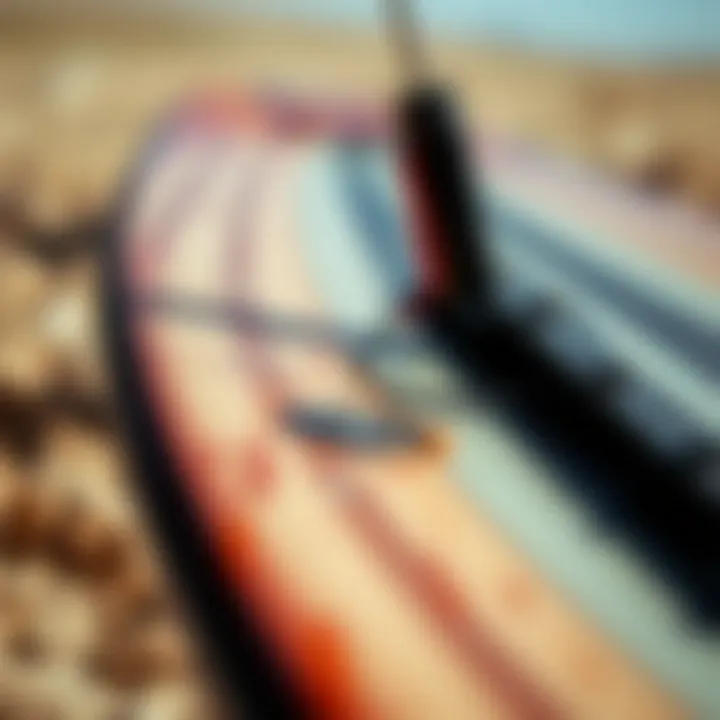
Personal Flotation Devices: Importance and Recommendations
Personal Flotation Devices (PFDs) are non-negotiable for anyone engaging in water sports. They not only ensure buoyancy but also offer crucial impact protection. In kiteboarding, unexpected falls into the water can happen, so utilizing a PFD can be a lifesaver.
Here are key considerations for selecting a PFD:
- Fit: It needs to be snug but not restrictive. Ensure that it allows for ample movement during routines.
- Type: There are many types, from the low profile vest-style ones to more buoyant options designed for larger bodies of water. Each varies in comfort and function, so pick one that fits your style.
- Visibility: Choose bright colors or reflective materials that increase your visibility during water activities. This can be crucial for your safety and the safety of others around you.
Accessories to Enhance the Experience
When kiteboarding, it's not just about mastering the wind or finding the perfect spot on the water; selecting the right accessories can mean the difference between a successful day out and a frustrating trip. Accessories for kiteboarding are essential tools that complement core gear and can enhance both performance and enjoyment.
In this segment, we will explore three key accessories: kitebags, wetsuits, and footwear. Each plays a critical role in ensuring that your kiteboarding experience is not only enjoyable but also safe and efficient.
Kitebags: Protecting Your Investment
A kite can be an expensive purchase and the last thing you want is for it to get damaged before hitting the waves. Kitebags are specifically designed to protect and transport your kites safely. A well-made kitebag should offer ample cushioning to shield against impacts and abrasions.
- Durability is crucial; look for bags made with robust materials like Cordura or canvas.
- Size Matters: Ensure that the bag can accommodate not just your kite, but also the control lines and accessories.
- Additional Features: Many kitebags come with extra compartments, providing space for items like your harness and wetsuit.
Investing in a quality kitebag is akin to buying insurance for your kite—by keeping it protected from the everyday rigors of travel and handling, you can extend its longevity.
Wetsuits: Finding the Right Fit
Wetsuits are not just about staying warm in cooler waters; they also provide protection against skin irritation from saltwater and wind. A wetsuit that fits well should be snug but not restrictive, allowing for ease of movement while you’re powering through those waves.
- Thickness: Depending on your local climates, wetsuits come in various thicknesses from 1mm for warm waters to 5mm or more for cold conditions.
- Neoprene Quality: Higher quality neoprene allows for better flexibility and warmth. Look for brands known for their comfort and performance.
- Style Options: Decide if you prefer a full suit, shorty, or even a spring suit, based on water temperature.
Choosing the right wetsuit can significantly affect your performance and comfort. For instance, a suit that’s too loose can lead to cold water flushing in and out, making for a less enjoyable experience.
Footwear: Selection for Performance
While it may seem trivial, the right footwear can enhance grip and comfort while kiteboarding. Many riders prefer to use booties, which provide a barrier against rough surfaces and chilly waters.
- Material: Look for footwear made from neoprene, as it offers insulation while remaining flexible.
- Sole Design: A grippy sole is important for coupling with your board, ensuring that you can securely ride without slippage.
- Fit and Comfort: Ensure that the shoes fit snugly to avoid blisters, yet are comfortable enough for prolonged wear.
Having the right footwear not only elevates your performance but can also drastically improve your overall enjoyment on the water.
"The right accessories can transform a good kiteboarding day into a great one, elevating both safety and performance."
In summary, kitebags, wetsuits, and footwear may not make the headlines, but they are integral components of a successful kiteboarding adventure. Selecting high-quality gear in these areas can greatly enhance your experience, giving you the confidence to tackle the waves with ease.
Maintenance and Care of Equipment
Keeping your kiteboarding gear in good shape is essential not just for performance, but for safety as well. When you're out on the water, the last thing you want to worry about is equipment failure. Regular maintenance and care can extend the lifespan of your gear, ensuring each kite session is enjoyable rather than stressful.
Establishing a routine for caring for your equipment also enhances its overall performance. Kites and boards that receive proper maintenance can perform at peak levels, providing the rider with better stability and control. With the right practices in place, you'll increase your confidence in the gear you rely on to navigate those waves.
Cleaning and Storing Kites and Boards
One of the first steps in maintenance is cleaning your kites and boards after each session. Saltwater and sand can be the enemy of your kite gear if left unchecked. Rinsing your kite and board with fresh water can help remove harmful elements that cause wear over time.
For the kites, it’s advisable to spread them out on a clean surface to dry completely before storing. Moisture can result in mold or discoloration, and nobody wants that, right? Hang your kite or lay it flat with the sail-side up, avoiding creases that can weaken the material.
When it comes to your board, ensure it’s clean and dry. Store it in a place away from direct sunlight, which can cause colors to fade and materials to deteriorate. A padded bag can provide extra protection against accidental bumps or scratches, making a world of difference in keeping your gear looking fresh for years.
Routine Inspections and Repairs
Inspections are not only a good practice; they’re essential. Before each kite session, take some time to examine your equipment closely. Look for tears, frayed lines, or anything unusual about the kite or the board.
- Kite lines should be checked for knots or wear. They bear a lot of stress during use, so any signs of damage need immediate attention.
- Sail fabric should be scrutinized for punctures or blisters. These can grow into larger issues if not treated.
- The board’s surface should be checked for dings or cracks—these can affect the ride and may lead to water infiltration.
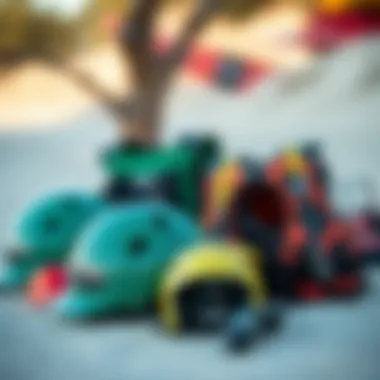
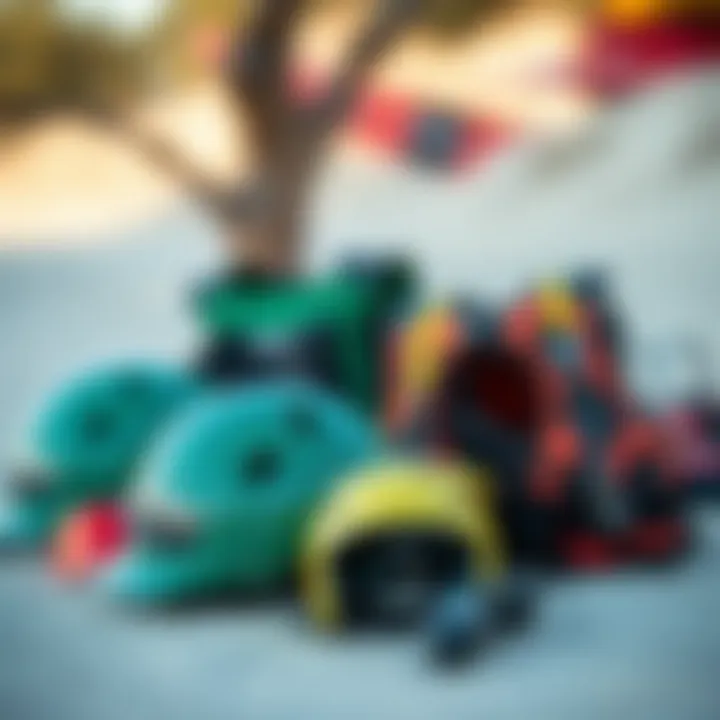
If you notice any issues, don’t simply brush them off. Repairs can often be done at home with a kite repair kit. Know that ignoring small issues can result in bigger troubles down the line, potentially costing more in repairs or replacements.
In essence, taking care of your kiteboarding equipment means more days of fun on the water. If you maintain your gear like you’d maintain your best friend— with care and vigilance—you’ll ensure that both you and your equipment are ready to tackle every wave with confidence.
Technological Innovations in Kiteboarding Gear
In the rapidly evolving world of kiteboarding, innovation is the name of the game. As kiteboarders aim for that perfect ride, advancements in technology bring new levels of performance, safety, and enjoyment. Modern equipment is no longer just about size and shape; it dives deep into using cutting-edge materials and smart accessories that make a significant difference in how we experience the sport. This section will delve into the latest technological innovations shaping the kiteboarding landscape, highlighting both their benefits and considerations.
Advanced Materials: Impact on Performance
Gone are the days when kiteboarding gear was bulky and heavy. The introduction of advanced materials, such as Dyneema and carbon fiber, has transformed the performance landscape. These materials are known for their strength-to-weight ratios, meaning they offer incredible durability without adding unnecessary ounces.
- Strength and Durability: These materials resist wear and tear much better than their predecessors, extending the lifespan of kites and boards. For example, a kite made of a high-quality ripstop nylon reinforced with Dyneema can withstand harsh conditions longer than those made from standard materials.
- Weight Reduction: A lighter kite allows for better maneuverability in the air. This is particularly crucial when trying to master tricks or ride in varied wind conditions. A kiteboard utilizing carbon fiber not only boasts lightness but also improves responsiveness—allowing riders to react quicker and perform more proficiently.
- Aerodynamics: Modern materials help enhance aerodynamics. When kites and boards are crafted from high-tech fabrics that minimize drag, riders can achieve higher speeds and perform tricks with more grace. This is a game-changer, offering an edge that can set a rider apart from the rest of the pack.
As advancements continue, kiteboarders have the chance to benefit from innovations that push the boundaries of performance.
Smart Accessories: The Role of Connectivity
With the rise of smart technology, it's no wonder that kiteboarding gear has also taken a leap into the digital realm. Smart accessories are emerging as critical tools for both safety and performance enhancement.
- GPS Tracking & Analytics: Devices that can connect to apps provide valuable insights into your riding stats. From speed to altitude, having this data can help you identify areas for improvement. Understanding your performance through analytical insights is like having a personal coach on the water.
- Safety Alerts: Some smart accessories come equipped with built-in failure detection technology. For instance, if your kite becomes detached, a smart device can send alerts or even outline the most efficient way back to your board or safety zone. This feature can be a lifesaver in unpredictable conditions.
- Performance Adjustments: Certain accessories can communicate with your gear to make real-time adjustments to settings based on wind conditions. Imagine a device that automatically adjusts the tension in your control lines depending on the wind speed. This capability can significantly enhance overall stability.
In a sport where split-second decisions are crucial, being connected can make all the difference. The convergence of technology and kiteboarding is paving the way for a new era in the sport.
"The beauty of kiteboarding lies in its ever-changing nature. As technologies adapt and evolve, so too do the skills and experiences of those who ride the wind and water."
For kiteboarders, these technological advancements are not merely luxuries, but essential components of high-performance gear. Keeping abreast of innovations not only enhances performance but also ensures a safer and more enjoyable kiteboarding experience.
Shopping for Kiteboarding Supplies
When it comes to kiteboarding, having the right gear is crucial for both performance and safety. The market is rife with various options, making it essential to be thorough in your research as you navigate through brands, models, and specifications. A well-informed purchase can make a world of difference, turning a sporadic session into a memorable day on the water.
Recognizing Reputable Brands
Selecting the right brands can simplify the shopping process significantly. Reputable brands are often characterized by their solid history, positive reviews, and unwavering commitment to quality. Some names you hear tossed around within the kiteboarding circles are Naish, Cabrinha, and Slingshot. These brands have been around long enough, testing their products under a variety of conditions, which is attested to by seasoned kiteboarders.
It’s wise to look for brands that have a strong customer service reputation as well. When things go wrong, like a torn kite or a malfunctioning control bar, knowing you can get support is invaluable. Here are some pointers when assessing a brand:
- Longevity: How long have they been in business?
- Reviews: What do other users say about their products?
- Product Range: Do they offer a variety that covers all your needs?
Checking out forums and community discussions on platforms such as Reddit or Facebook can guide you towards reliable brands which have garnered respect within the kiteboarding community.
Evaluating Products: Key Considerations
Purchasing kiteboarding gear requires careful consideration and evaluation of products to ensure they meet your specific needs and preferences. Here are some key factors to keep in mind:
- Suitability: Make sure the gear matches your skill level, whether you are a novice or a seasoned pro. For example, beginners may prefer kites with more stability to ease into the sport.
- Specifications: Check the technical specs of every item. Kites come in different sizes, and understanding the wind range and its compatibility with your board is important.
- Materials: Look for high-quality materials that withstand wear and tear. For instance, some kites are manufactured with ripstop nylon which is lighter yet strong.
- Comfort and Fit: Comfort is paramount, particularly when you are out for hours on end. Try on harnesses and wetsuits to make sure they fit right. An uncomfortable setup can distract and potentially put you at risk.
- Price Comparisons: While it may be tempting to pinch pennies, the cheapest option often leads to compromised safety and performance. Compare prices but don’t sacrifice quality. A slightly more expensive harness from a dependable brand may save you from injuries down the line.
In the end, a considered approach to shopping for kiteboarding supplies not only enhances your overall experience but also significantly contributes to your safety on the water. Leveraging the strengths of reputable brands and aligning your choices with solid evaluation principles will set you on the path to a fruitful kiteboarding journey.
Closure
As we wrap up our exploration of essential kiteboarding supplies, it becomes clear that being well-informed about your gear is crucial for a safe and enjoyable experience on the water. Kiteboarding can be an exhilarating sport, but it also comes with its fair share of risks. Choosing the right equipment alongside proper safety measures can significantly influence both your performance and safety.
Recap of Essential Equipment
In looking back over the different components discussed, it's vital to highlight the core supplies that every kiteboarder should consider.
Here’s a brief rundown:
- Kites: The heart of kiteboarding, kites come in varied designs and sizes tailored for specific conditions. Selecting the right one involves understanding your skill level, wind conditions, and style of riding.
- Boards: These vary too; whether you go for a twin-tip or a directional board, picking one that complements your kite is key.
- Harness & Safety Gear: Your harness connects you to the kite and your safety gear—such as helmets and PFDs—minimizes risks during kiting.
- Control Bars and Lines: Essential for steering and control, these components require attention to detail in choosing the right specifications for your needs.
Taking the time to familiarize yourself with each element not only enhances your skill but also your confidence on the water. Like they say, practice makes perfect, but good equipment helps too.
Final Thoughts on Gear Selection
When it comes to selecting kiteboarding gear, the decision-making process can feel overwhelming at times. However, a well-thought-out approach can go a long way. Start by recognizing reliable brands and knowing what specifications work for you.
Consider trying gear before committing—renting can help with this. Moreover, following the latest advancements in equipment technology, including materials and design, ensures you're not left in the dust compared to your peers.
Remember, it’s not just about having the flashiest gear but finding what feels right for you. In the end, always prioritize safety and personal comfort over trends.
By investing time in researching and selecting the right equipment, you set a solid foundation for mastering kiteboarding and truly enjoying everything the sport has to offer.
For more resources and community support, consider visiting platforms like Reddit or Wikipedia where enthusiasts share their insights and experiences.















